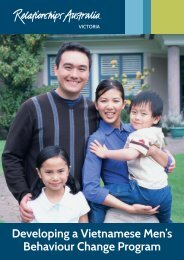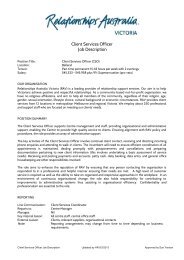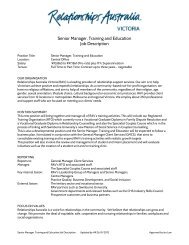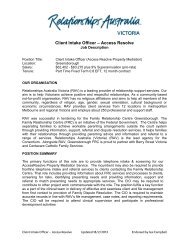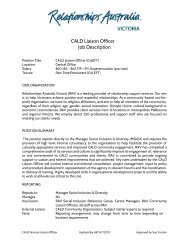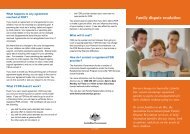Engaging fathers in child and family services - Australian Institute of ...
Engaging fathers in child and family services - Australian Institute of ...
Engaging fathers in child and family services - Australian Institute of ...
- No tags were found...
You also want an ePaper? Increase the reach of your titles
YUMPU automatically turns print PDFs into web optimized ePapers that Google loves.
Build staff <strong>and</strong> program capacity to engage with <strong>fathers</strong>• Whether male or female, all workers require tra<strong>in</strong><strong>in</strong>g <strong>in</strong> how to engage with <strong>fathers</strong>.• Be<strong>in</strong>g a man or a father is not necessarily go<strong>in</strong>g to enhance a practitioner’s ability to engagewith <strong>fathers</strong>—although <strong>in</strong> some circumstances <strong>fathers</strong> may feel more comfortable with a malefacilitator.• The emotional stereotyp<strong>in</strong>g <strong>of</strong> men (e.g., “men don’t express their emotions”, “men are afraid<strong>of</strong> their feel<strong>in</strong>gs”) has been shown to reduce practitioners’ effectiveness when conduct<strong>in</strong>g<strong>family</strong> relationship work.• The ability to <strong>in</strong>clude <strong>fathers</strong> <strong>in</strong> <strong>child</strong> <strong>and</strong> <strong>family</strong> <strong>services</strong> requires a range <strong>of</strong> competencies.Some <strong>of</strong> the key competencies are:––experience work<strong>in</strong>g with men;––the ability to work with <strong>fathers</strong> <strong>in</strong> a one-on-one or group sett<strong>in</strong>g;––skills <strong>in</strong> form<strong>in</strong>g productive relationships with clients;––the ability to relate to others through personal experience; <strong>and</strong>––the ability to reflect upon <strong>and</strong> respond to cultural stereotypes about men <strong>and</strong> how thesestereotypes may impact upon their own attitudes <strong>and</strong> practice.• Competency work<strong>in</strong>g with men is an ongo<strong>in</strong>g process. Practitioners will cont<strong>in</strong>ue to learn asthey cont<strong>in</strong>ue to work with men.• The follow<strong>in</strong>g program characteristics may improve capacity to engage with <strong>fathers</strong>:––consider<strong>in</strong>g how to <strong>in</strong>clude <strong>fathers</strong> at the plann<strong>in</strong>g stage <strong>of</strong> a program;––a commitment from all staff for father <strong>in</strong>clusion; <strong>and</strong>––a staff member dedicated to engag<strong>in</strong>g with men.Questions to consider <strong>in</strong> plann<strong>in</strong>g <strong>and</strong> delivery <strong>of</strong> <strong>services</strong>:• What tra<strong>in</strong><strong>in</strong>g opportunities are available for staff to help them develop the competencies to work with <strong>fathers</strong>?• Are staff given an opportunity to reflect upon stereotypes about men <strong>and</strong> how this might impact upon theirpractice?• Are there opportunities for <strong>fathers</strong> to provide feedback about the service/program?For more <strong>in</strong>formation <strong>and</strong> further discussion on build<strong>in</strong>g the capacity <strong>of</strong> staff to work with <strong>fathers</strong> see: Fletcher (2004,pp. 87–88; 2008), The University <strong>of</strong> Newcastle (2008b), Berlyn et al. (2008, p. 26), <strong>and</strong> Lloyd et al. (2003).Adopt a strengths-based approach to <strong>fathers</strong> <strong>and</strong> father<strong>in</strong>g• Research demonstrates that a strengths-based approach with parents <strong>in</strong>creases the effectiveness<strong>of</strong> a program <strong>and</strong> improves parental engagement.• A strengths-based approach to <strong>fathers</strong> <strong>and</strong> father<strong>in</strong>g is characterised by a focus upon <strong>fathers</strong>’capacities <strong>and</strong> the value <strong>of</strong> father<strong>in</strong>g. In practice this can be:––shar<strong>in</strong>g <strong>in</strong>formation with <strong>fathers</strong> about how they already contribute <strong>and</strong> how they canfurther contribute to the wellbe<strong>in</strong>g <strong>of</strong> <strong>child</strong>ren; <strong>and</strong>––resist<strong>in</strong>g an “expert” approach.• A strengths-based approach to <strong>fathers</strong> <strong>and</strong> father<strong>in</strong>g is especially important because:––<strong>fathers</strong>’ competence <strong>in</strong> deal<strong>in</strong>g with the emotional aspects <strong>of</strong> parent<strong>in</strong>g small <strong>child</strong>ren canbe underestimated with<strong>in</strong> their own families <strong>and</strong> <strong>in</strong> the general community; <strong>and</strong>CAFCA Practice Sheet | 5




